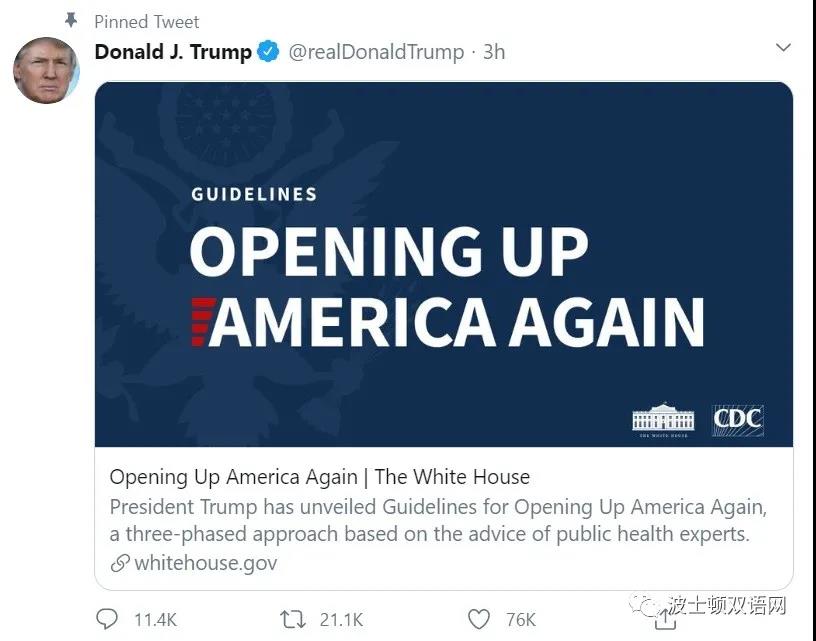【波士顿双语网2020年4月16日讯】美国累计新冠病毒感染者达到67.3万人,死亡人数超过3万,新增死亡人数1889人。全美平均新冠肺炎患者的病死率为4.5%,宾州、麻州和加州的病死率在3.5%以下,而密西根州的病死率高达6.9%。

特朗普今天在白宫记者会中宣布,将逐步重开美国经济。联邦政府出台疫情下重开经济的指引,而各州州长将决定何时允许商户开门营业。他说:“我们必须有一个运作正常的经济,我们将很快重启,”
今天上午,小型企业管理局(SBA)在其网站上表示,该机构“根据可用的配额,已无法接受新的申请”,这个计划的资金在两周内就用完了。目前,美国陷入自大萧条以来未曾出现的失业水平,国会似乎不太可能解决这个日益严重的问题。国会议员们无法就如何增加总额为3,500亿美元的工资保障计划(PPP)达成一致。
该计划是三周前通过的庞大的2万亿美元经济救援法的核心部分。共和党和民主党人说,需要在法律基础上采取更多行动,但他们不能就该怎么做达成共识。经济继续崩溃,但立法者分散在全国各地,相互冲突和争吵。

在过去一个月中,2200万人申请了失业救济金,这是美国失业人数记录最高点,这使在金融危机之后的十年来增加的就业人数的成果归于零。劳工部周四表示,上周约有520万人申请失业救济。失业救济申请人数是统计全国失业率的最佳方法。彭博社调查的经济学家估计,上周有550万美国人首次申请失业保险。这使过去四个星期的申请总额达到了惊人的2200万。另一方面,自2008年金融大海啸以来,劳动力市场增加了2150万个工作岗位。
美东多州隔离将延长到5月15日
纽约州州长安德鲁·科莫(Andrew Cuomo)4月16日周四表示,纽约和其他东海岸州将关闭非必要业务的时间延长至5月15日,政府正在努力寻找办法解决如何重新开放部分经济而不会导致冠状病毒疫情再度爆发的问题。
特朗普称,美国已经度过了疫情最高点,新增确诊案例数呈下降趋势。白宫今天公布了三个阶段的指引。疫情最严重的地区将维持社交疏离,避免十人以上的聚会,尽量减少非必须旅行,而高危人群将继续居家隔离。处于第二阶段的地区则可以进行非必要旅行,将聚会控制在50人以内,并且重开学校、托儿所等公众聚集场所。
而在情况最为理想的第三阶段,工作场所基本可正常运作,高危人群可在保持社交距离的前提下与外界接触,而低危人群则尽量减少在拥挤环境中停留的时间。
尽管特朗普此前多次表示重开经济该由总统做主,他当日表示,何时重开的决定将交由州长根据各州的情况而定。特朗普则表示:“如果秋天疫情卷土重来,一些科学家说有这个可能,届时这些指引会迅速扑灭疫情。”
白宫抗疫小组的医学专家弗契医生专家(Anthony Fauci)称,第三阶段可称为“新常态”,但并不意味着抗疫终结。他警告,疫情可能卷土重来。“但我认为,在疫苗出现之前,我们可以应对。”
白宫网站公布了三阶段重启经济,详情如下。

President Trump has unveiled Guidelines for Opening Up America Again, a three-phased approach based on the advice of public health experts. These steps will help state and local officials when reopening their economies, getting people back to work, and continuing to protect American lives.
Phase One
For States and Regions that satisfy the gating criteria
INDIVIDUALS
ALL VULNERABLE INDIVIDUALS should continue to shelter in place. Members of households with vulnerable residents should be aware that by returning to work or other environments where distancing is not practical, they could carry the virus back home. Precautions should be taken to isolate from vulnerable residents.
All individuals, WHEN IN PUBLIC (e.g., parks, outdoor recreation areas, shopping areas), should maximize physical distance from others. Social settings of more than 10 people, where appropriate distancing may not be practical, should be avoided unless precautionary measures are observed.
Avoid SOCIALIZING in groups of more than 10 people in circumstances that do not readily allow for appropriate physical distancing (e.g., receptions, trade shows)
MINIMIZE NON-ESSENTIAL TRAVEL and adhere to CDC guidelines regarding isolation following travel.
EMPLOYERS
Continue to ENCOURAGE TELEWORK, whenever possible and feasible with business operations.
If possible, RETURN TO WORK IN PHASES.
Close COMMON AREAS where personnel are likely to congregate and interact, or enforce strict social distancing protocols.
Minimize NON-ESSENTIAL TRAVEL and adhere to CDC guidelines regarding isolation following travel.
Strongly consider SPECIAL ACCOMMODATIONS for personnel who are members of a VULNERABLE POPULATION.
SPECIFIC TYPES OF EMPLOYERS
SCHOOLS AND ORGANIZED YOUTH ACTIVITIES (e.g., daycare, camp) that are currently closed should remain closed.
VISITS TO SENIOR LIVING FACILITIES AND HOSPITALS should be prohibited. Those who do interact with residents and patients must adhere to strict protocols regarding hygiene.
LARGE VENUES (e.g., sit-down dining, movie theaters, sporting venues, places of worship) can operate under strict physical distancing protocols.
ELECTIVE SURGERIES can resume, as clinically appropriate, on an outpatient basis at facilities that adhere to CMS guidelines.
GYMS can open if they adhere to strict physical distancing and sanitation protocols.
BARS should remain closed.
Phase Two
For States and Regions with no evidence of a rebound and that satisfy the gating criteria a second time
INDIVIDUALS
ALL VULNERABLE INDIVIDUALS should continue to shelter in place. Members of households with vulnerable residents should be aware that by returning to work or other environments where distancing is not practical, they could carry the virus back home. Precautions should be taken to isolate from vulnerable residents.
All individuals, WHEN IN PUBLIC (e.g., parks, outdoor recreation areas, shopping areas), should maximize physical distance from others. Social settings of more than 50 people, where appropriate distancing may not be practical, should be avoided unless precautionary measures are observed.
NON-ESSENTIAL TRAVEL can resume.
EMPLOYERS
Continue to ENCOURAGE TELEWORK, whenever possible and feasible with business operations.
Close COMMON AREAS where personnel are likely to congregate and interact, or enforce moderate social distancing protocols.
Strongly consider SPECIAL ACCOMMODATIONS for personnel who are members of a VULNERABLE POPULATION.
SPECIFIC TYPES OF EMPLOYERS
SCHOOLS AND ORGANIZED YOUTH ACTIVITIES (e.g., daycare, camp) can reopen.
VISITS TO SENIOR CARE FACILITIES AND HOSPITALS should be prohibited. Those who do interact with residents and patients must adhere to strict protocols regarding hygiene.
LARGE VENUES (e.g., sit-down dining, movie theaters, sporting venues, places of worship) can operate under moderate physical distancing protocols.
ELECTIVE SURGERIES can resume, as clinically appropriate, on an outpatient and in-patient basis at facilities that adhere to CMS guidelines.
GYMS can remain open if they adhere to strict physical distancing and sanitation protocols.
BARS may operate with diminished standing-room occupancy, where applicable and appropriate.
Phase Three
For States and Regions with no evidence of a rebound and that satisfy the gating criteria a third time
INDIVIDUALS
VULNERABLE INDIVIDUALS can resume public interactions, but should practice physical distancing, minimizing exposure to social settings where distancing may not be practical, unless precautionary measures are observed.
LOW-RISK POPULATIONS should consider minimizing time spent in crowded environments.
EMPLOYERS
Resume UNRESTRICTED STAFFING of worksites.
SPECIFIC TYPES OF EMPLOYERS
VISITS TO SENIOR CARE FACILITIES AND HOSPITALS can resume. Those who interact with residents and patients must be diligent regarding hygiene.
LARGE VENUES (e.g., sit-down dining, movie theaters, sporting venues, places of worship) can operate under limited physical distancing protocols.
GYMS can remain open if they adhere to standard sanitation protocols.
BARS may operate with increased standing room occupancy, where applicable.
APPENDIX
Vulnerable Individuals
Elderly individuals.
Individuals with serious underlying health conditions, including high blood pressure, chronic lung disease, diabetes, obesity, asthma, and those whose immune system is compromised such as by chemotherapy for cancer and other conditions requiring such therapy.